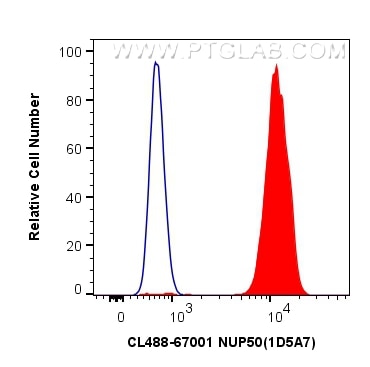- Featured Product
- KD/KO Validated
NUP50 Monoklonaler Antikörper
NUP50 Monoklonal Antikörper für FC (Intra)
Wirt / Isotyp
Maus / IgG1
Getestete Reaktivität
human
Anwendung
FC (Intra)
Konjugation
CoraLite® Plus 488 Fluorescent Dye
CloneNo.
1D5A7
Kat-Nr. : CL488-67001
Synonyme
Geprüfte Anwendungen
| Erfolgreiche Detektion in FC (Intra) | HL-60-Zellen |
Empfohlene Verdünnung
| Anwendung | Verdünnung |
|---|---|
| Durchflusszytometrie (FC) (INTRA) | FC (INTRA) : 0.40 ug per 10^6 cells in a 100 µl suspension |
| It is recommended that this reagent should be titrated in each testing system to obtain optimal results. | |
| Sample-dependent, check data in validation data gallery | |
Produktinformation
CL488-67001 bindet in FC (Intra) NUP50 und zeigt Reaktivität mit human
| Getestete Reaktivität | human |
| Wirt / Isotyp | Maus / IgG1 |
| Klonalität | Monoklonal |
| Typ | Antikörper |
| Immunogen | NUP50 fusion protein Ag15144 |
| Vollständiger Name | nucleoporin 50kDa |
| Berechnetes Molekulargewicht | 468 aa, 50 kDa |
| Beobachtetes Molekulargewicht | 50-55 kDa |
| GenBank-Zugangsnummer | BC028125 |
| Gene symbol | NUP50 |
| Gene ID (NCBI) | 10762 |
| Konjugation | CoraLite® Plus 488 Fluorescent Dye |
| Excitation/Emission maxima wavelengths | 493 nm / 522 nm |
| Form | Liquid |
| Reinigungsmethode | Protein-G-Reinigung |
| Lagerungspuffer | PBS with 50% glycerol, 0.05% Proclin300, 0.5% BSA |
| Lagerungsbedingungen | Bei -20°C lagern. Vor Licht schützen. Nach dem Versand ein Jahr stabil. Aliquotieren ist bei -20oC Lagerung nicht notwendig. 20ul Größen enthalten 0,1% BSA. |
Hintergrundinformationen
Nup50 (also known as Npap60) is a nucleoporin that binds directly to importin α and their interaction plays an important role in nuclear import. Nup50 is a mobile nucleoporin localized primarily in the nuclear basket of the nuclear pore complex (NPC) and in the nucleoplasm. Human Nup50 has two isoforms: Npap60L (1-469 aa), and its alternatively spliced isoform, Npap60S (29-469 aa) of Npap60L.
Protokolle
| PRODUKTSPEZIFISCHE PROTOKOLLE | |
|---|---|
| FC protocol for CL Plus 488 NUP50 antibody CL488-67001 | Download protocol |
| STANDARD-PROTOKOLLE | |
|---|---|
| Klicken Sie hier, um unsere Standardprotokolle anzuzeigen |


